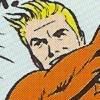Post by Eyalan on Aug 1, 2006 7:01:39 GMT -5
The Maiar that are listed are from my point of view the most powerfull Maiar of Arda. If you disagree, vote 'other'.
For those who need a memory boost, I'll give a short discription of all Maiar above:
Sauron, Lord of Darkness
In the earliest of days, before the godlike Valar entered the realm of Arda, Sauron originated as a spirit called a Maia. He was at first one of the most powerful servants of Aulë the Smith, one of the Valar or ruling powers of the world.
As a Maia, Sauron was able to change his appearance for many years. In the beginning he likely wore a fair and noble seeming most of the time, but after switching his allegiance to Morgoth he frequently took the appearance of a dark and terrible shadow. As part of a plan to destroy Huan, Sauron took the form of the greatest werewolf which had been on Middle-earth up to that time, and then assumed several other forms when attempting to escape. He took a beautiful appearance once again at the end of the First Age in an effort to deceive Eönwë. He either remained such, or took this form again when appearing as Annatar to the Elves.
Gandalf the White
Gandalf was the best-known of the Maiar of Valinor, a servant of the Valar, the Powers of the world, and of Eru Ilúvatar, the One.
He seemed the oldest and least wise of them, but Círdan the Shipwright felt great power around him, and gave him the Ring of Fire.
In 2463 TA, the White Council was founded. Galadriel proposed that Gandalf be made the head of it, but he refused, and the position of leadership was given over to Saruman. Gandalf then led the final battle against Sauron's forces at the Black Gate, waging an outnumbered battle to distract the Dark Lord's attention away from Frodo and Sam, who were at the very same moment scaling Mount Doom to destroy the Ring. Before the battle Gandalf and the other leaders of the West went to try to negotiate with the Mouth of Sauron, with Gandalf as chief herald and negotiator.
Saruman the White
Knowledge of the "deep arts" (or magic, such as it is in Middle-earth) was of particular interest to him, especially when relating to power—such as the Rings of Power and the far seeing palantíri. He was also deeply learned in ancient lore regarding powerful kingdoms such as Númenor, Gondor and Moria. His voice and speech were extremely convincing, more powerful than mere rhetoric. When he focused this power on a person or a group of people, he could sway their hearts, plant fears and sow lies as he pleased. Depending on the willpower of the listener, this spell could last as long as the speech did, or it could take root in them and last forever.
Eönwë, the Banner Bearer
Eönwë was the banner-bearer and the herald of Manwë, and Chief of the Maiar along with Ilmarë. Eönwë was referred to as the "greatest of arms in Arda," meaning that he was the best with weapons, although not necessarily the most powerful.
When the appeal of Eärendil reached the shores of Aman, it was Eönwë who first greeted him. When Manwë decided to heed the appeal, Eönwë was sent to Middle-earth to fight the War of Wrath, leading the Vanyar.
When Morgoth the Black Foe was defeated, Eönwë took the two remaining Silmarils and held them for safekeeping. The two remaining Sons of Fëanor took them and fled, yet Eönwë did not let them be slain.
Ilmarë, handmaiden of Varda
She was chief among the Maiar and the handmaiden to Varda. She is only mentioned briefly in the Valaquenta, where she is described as one of the chiefs of the Maiar. In The Book of Lost Tales it is implied that she was supposed to be the daughter of Manwë and Varda, but Tolkien appears to have changed this in the Silmarillion and most readers accept that she was simply created by Ilúvatar like the Valar.
Gothmog, Lord of the Balrogs
While Sauron is widely considered to be Morgoth's second in command, Gothmog was clearly Morgoth's champion in arms as his armies dealt the Noldor their most crushing defeats on the battlefields of Beleriand. He carried a black axe and fought in the Dagor-nuin-Giliath, where he mortally wounded Fëanor. He killed two Kings of the Ñoldor: Fëanor in the Dagor-nuin-Giliath, and Fingon in the Nirnaeth Arnoediad.
For those who need a memory boost, I'll give a short discription of all Maiar above:
Sauron, Lord of Darkness
In the earliest of days, before the godlike Valar entered the realm of Arda, Sauron originated as a spirit called a Maia. He was at first one of the most powerful servants of Aulë the Smith, one of the Valar or ruling powers of the world.
As a Maia, Sauron was able to change his appearance for many years. In the beginning he likely wore a fair and noble seeming most of the time, but after switching his allegiance to Morgoth he frequently took the appearance of a dark and terrible shadow. As part of a plan to destroy Huan, Sauron took the form of the greatest werewolf which had been on Middle-earth up to that time, and then assumed several other forms when attempting to escape. He took a beautiful appearance once again at the end of the First Age in an effort to deceive Eönwë. He either remained such, or took this form again when appearing as Annatar to the Elves.
Gandalf the White
Gandalf was the best-known of the Maiar of Valinor, a servant of the Valar, the Powers of the world, and of Eru Ilúvatar, the One.
He seemed the oldest and least wise of them, but Círdan the Shipwright felt great power around him, and gave him the Ring of Fire.
In 2463 TA, the White Council was founded. Galadriel proposed that Gandalf be made the head of it, but he refused, and the position of leadership was given over to Saruman. Gandalf then led the final battle against Sauron's forces at the Black Gate, waging an outnumbered battle to distract the Dark Lord's attention away from Frodo and Sam, who were at the very same moment scaling Mount Doom to destroy the Ring. Before the battle Gandalf and the other leaders of the West went to try to negotiate with the Mouth of Sauron, with Gandalf as chief herald and negotiator.
Saruman the White
Knowledge of the "deep arts" (or magic, such as it is in Middle-earth) was of particular interest to him, especially when relating to power—such as the Rings of Power and the far seeing palantíri. He was also deeply learned in ancient lore regarding powerful kingdoms such as Númenor, Gondor and Moria. His voice and speech were extremely convincing, more powerful than mere rhetoric. When he focused this power on a person or a group of people, he could sway their hearts, plant fears and sow lies as he pleased. Depending on the willpower of the listener, this spell could last as long as the speech did, or it could take root in them and last forever.
Eönwë, the Banner Bearer
Eönwë was the banner-bearer and the herald of Manwë, and Chief of the Maiar along with Ilmarë. Eönwë was referred to as the "greatest of arms in Arda," meaning that he was the best with weapons, although not necessarily the most powerful.
When the appeal of Eärendil reached the shores of Aman, it was Eönwë who first greeted him. When Manwë decided to heed the appeal, Eönwë was sent to Middle-earth to fight the War of Wrath, leading the Vanyar.
When Morgoth the Black Foe was defeated, Eönwë took the two remaining Silmarils and held them for safekeeping. The two remaining Sons of Fëanor took them and fled, yet Eönwë did not let them be slain.
Ilmarë, handmaiden of Varda
She was chief among the Maiar and the handmaiden to Varda. She is only mentioned briefly in the Valaquenta, where she is described as one of the chiefs of the Maiar. In The Book of Lost Tales it is implied that she was supposed to be the daughter of Manwë and Varda, but Tolkien appears to have changed this in the Silmarillion and most readers accept that she was simply created by Ilúvatar like the Valar.
Gothmog, Lord of the Balrogs
While Sauron is widely considered to be Morgoth's second in command, Gothmog was clearly Morgoth's champion in arms as his armies dealt the Noldor their most crushing defeats on the battlefields of Beleriand. He carried a black axe and fought in the Dagor-nuin-Giliath, where he mortally wounded Fëanor. He killed two Kings of the Ñoldor: Fëanor in the Dagor-nuin-Giliath, and Fingon in the Nirnaeth Arnoediad.






 )
)

 Well, I myself voted for Gandalf. If you think, he was the greatest. To support my theory, I will state these comments.
Well, I myself voted for Gandalf. If you think, he was the greatest. To support my theory, I will state these comments. ~Attained 1000 posts on April 6th at 3:22 pm.~
~Attained 1000 posts on April 6th at 3:22 pm.~
